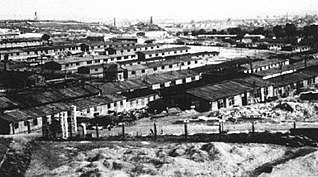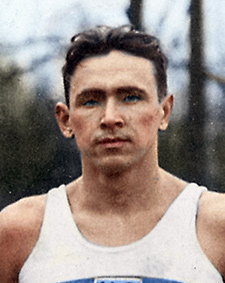 W
WMarianna Biernacka, née Czokało was a Roman Catholic citizen of Poland, and a victim of Nazi Germany in the Second World War. She is one of the beatified 108 Martyrs of World War II, a group also known as the 108 Blessed Polish Martyrs.
 W
WSławomir Maciej Bittner was a Polish scoutmaster (podharcmistrz) and second lieutenant of the Armia Krajowa.
 W
WAbraham Blum was Polish-Jewish socialist activist, one of the leaders of the Bund in the Warsaw Ghetto and a participant in the Warsaw Ghetto Uprising.
 W
WAdolf Bniński was a Polish agricultural, conservative and royalist activist. He was Voivode of Poznań from 1923-1928 and a member of the Senate of Poland in the Second Polish Republic. In the aftermath of the German invasion of Poland he was the Government Delegate for Poland for the Polish territories annexed by Nazi Germany. He was arrested by the Germans in July 1941 and killed in 1942.
 W
WStefan Władysław Bryła was a Polish construction engineer and welding pioneer. He designed and built the first welded road bridge in the world.
Stanisław Bułak-Bałachowicz was a notable general, military commander and veteran of World War I, the Russian Civil War, the Estonian War of Independence, the Polish-Bolshevik War and the Invasion of Poland at the start of World War II.
 W
WAlfons Flisykowski was a Polish worker of the Polish Post Office in the Free City of Danzig in the years 1923–1939 and a second commander of the defence of the Post Office from the invading Nazi German forces when World War II started on 1 September 1939.
 W
WBlessed Grzegorz (Gregory) Bolesław Frąckowiak was a Society of the Divine Word martyr. He was beatified by Pope John Paul II on 13 June 1999 as one of the 108 Polish Martyrs of World War II.
 W
WAndrzej Garbuliński was a Polish farmer who lived in the village of Czerna with his family – Władysław, Eleonora, Marian, Helena, Kunegunda, Stanisław, Kazimierz, and Jan – during the Nazi German occupation of Poland in World War II. He and his eldest son Władysław were executed by the Nazis in late 1943 for aiding and sheltering Jews.
 W
WMordka Mendel Grossman, artistic graphic, photographer, worker in the Statistical Department of the Litzmannstadt Ghetto.
 W
WSzlama Grzywacz (1909-1944) was one of the members of the French resistance executed at the fort of Mont Valérien as a member of the Manouchian group, a volunteer of the French liberation army FTP-MOI. His name is one of the ten which featured on the Affiche Rouge displayed by the Germans during the trial of the 23 captured members of the Manouchian group. His photograph is displayed with the caption Grzywacz juif polonais 2 attentats.
 W
WLeon Heyke was a Roman Catholic priest, theologian, educator, poet and Kashubian-Polish activist.
 W
WKarol Hiller was a Polish painter. He was one of the main representatives of the Polish constructivist movement in the 1920s.
 W
WTadeusz Hollender (1910–1943) was a Polish poet, translator and humorist. During World War II, he wrote satirical articles and poems in underground press, for that he was arrested by the German Gestapo and executed in May in the infamous prison, Pawiak.
 W
WJanina Hosiasson-Lindenbaum was a Polish logician and philosopher. She published some twenty research papers along with translations into Polish of three books by Bertrand Russell. The main focus of her writings was on foundational problems related to probability, induction and confirmation. She is noted especially for authoring the first printed discussion of the Raven Paradox which she credits to Carl Hempel and the probabilistic solution she outlined to it. Shot by the Gestapo in 1942, she, like her husband Adolf Lindenbaum, and many other eminent representatives of Polish logic such as Mojżesz Presburger, shared the fate of millions of Jews murdered on Polish soil by the Nazis.
 W
WWitold Hulewicz (1895–1941) was a Polish poet, literary critic, translator and publisher. Best known for his translations of German language literature, including most of the published works of his personal friend Rainer Maria Rilke, Hulewicz was also one of the pioneers of radio in Poland: he was the first director of the Wilno-based Polish Radio Wilno, one of the most popular Polish radio stations of the 1920s and 1930s. He also published numerous literary and artistic journals. Arrested by the Germans during World War II as part of their AB-Aktion, Witold Hulewicz was murdered at Palmiry in 1941.
 W
WJerzy Iwanow-Szajnowicz was a Greek-Polish athlete who fought as a saboteur in the Greek Resistance during World War II and was executed by the Germans.
 W
WEdmund Bernard Jankowski was a Polish rower who competed in the 1928 Summer Olympics.
 W
WAlicja Jadwiga Kotowska was a Polish nun, head of the Resurrectionist convent in Wejherowo between 1934 and 1939, and a blessed of the Roman Catholic Church and a martyr killed by the Germans in 1939 in the Mass murders in Piaśnica.
 W
WJanusz Tadeusz Kusociński was a Polish athlete, winner in the 10,000 meters event at the 1932 Summer Olympics.
 W
WAdolf Lindenbaum, was a Polish-Jewish logician and mathematician best known for Lindenbaum's lemma and Lindenbaum algebras.
 W
WRoman Longchamps de Bérier (1883–1941) was a Polish lawyer and university professor, one of the most notable specialists in civil law of his generation and the last rector of the Jan Kazimierz University of Lwów. He was murdered in what became known as the Massacre of Lwów professors.
 W
WFranciszek Nogalski was a Polish Roman Catholic priest and parochial vicar in Raciąż. He was executed by Nazi German occupants during the Rudzki Most massacre. Before his death Nogalski unsuccessfully tried to save other hostages by sacrificing himself. He has been accorded the title of Servant of God and he is one of the 122 Polish martyrs of the Second World War whose beatification process started in 2003.
 W
WStanisław Piasecki was a Polish right-wing activist, politician and journalist of partially Jewish descent.
 W
WJan Piekałkiewicz was a Polish economist and statistician, politician and the Polish Underground State's Government Delegate.
 W
WTadeusz Popek was a Polish partisan and underground activist during World War II. During the German occupation of Podhale, Popek became the co-founder of the Polish resistance organization called the Tatra Confederation, a.k.a. Confederation of the Tatra Mountains, operating in the Nowy Targ area. He was in charge of clandestine publications including Der Freie Deutsche meant for the Wehrmacht. Popek died in Zakopane, executed by a firing squad in the courtyard of the infamous Palace Hotel.
 W
WTadeusz Pruszkowski was a Polish painter and art teacher, known primarily for his portraits.
 W
WMarcel Rajman, alias Simon Maujean, Faculté, Michel, and Michel Mieczlav was a Polish Jew and volunteer fighter in the FTP-MOI group of French resistance fighters during World War II, and the head of "Stalingrad", a highly active militant group.
 W
WMaciej Rataj was a Polish politician and writer.
 W
WStanisław Ruziewicz was a Polish mathematician and one of the founders of the Lwów School of Mathematics.
 W
WLeon Sperling was a Polish Olympic footballer.
 W
WTomasz Stankiewicz was a Polish track cyclist who competed in the 1924 Summer Olympics. He was born in Warsaw and died in Palmiry, executed by Nazis.
 W
WPiotr Szarek was a Polish Catholic clergyman, member of the Congregation of the Mission, publicly murdered by the Nazis on the ninth day of the Second World War.
 W
WServants of God Józef and Wiktoria Ulma, a Polish husband and wife, living in Markowa near Rzeszów in south-eastern Poland during the Nazi German occupation in World War II, were the Righteous who attempted to rescue Polish Jewish families by hiding them in their own home during the Holocaust. They and their children were summarily executed on 24 March 1944 for doing so. Notably, despite the murder of Ulmas meant to strike fear into the hearts of villagers, their neighbours continued to hide Jewish fugitives until the end of World War II in Europe. At least 21 Polish Jews survived in Markowa during the occupation of Poland by Nazi Germany.
 W
WServants of God Józef and Wiktoria Ulma, a Polish husband and wife, living in Markowa near Rzeszów in south-eastern Poland during the Nazi German occupation in World War II, were the Righteous who attempted to rescue Polish Jewish families by hiding them in their own home during the Holocaust. They and their children were summarily executed on 24 March 1944 for doing so. Notably, despite the murder of Ulmas meant to strike fear into the hearts of villagers, their neighbours continued to hide Jewish fugitives until the end of World War II in Europe. At least 21 Polish Jews survived in Markowa during the occupation of Poland by Nazi Germany.
 W
WWolf Wajsbrot was a member of the French Resistance under the Nazi occupation. He was born in the Polish town of Kraśnik. His parents moved to France shortly after his birth due to increasing anti-semitism and a worsening economic climate, eventually settling in Paris.
 W
WServants of God Józef and Wiktoria Ulma, a Polish husband and wife, living in Markowa near Rzeszów in south-eastern Poland during the Nazi German occupation in World War II, were the Righteous who attempted to rescue Polish Jewish families by hiding them in their own home during the Holocaust. They and their children were summarily executed on 24 March 1944 for doing so. Notably, despite the murder of Ulmas meant to strike fear into the hearts of villagers, their neighbours continued to hide Jewish fugitives until the end of World War II in Europe. At least 21 Polish Jews survived in Markowa during the occupation of Poland by Nazi Germany.
 W
WStanisław Wiórek or alternatively Stanisław Wiorek was a Polish theologian and Catholic clergyman, member of the Congregation of the Mission, publicly murdered by the Nazis on the ninth day of the Second World War.
 W
WJanusz Rajmund Zalewski was a Polish sailor. He competed in the mixed 6 metres at the 1936 Summer Olympics. Zalewski was wounded during the Warsaw Uprising and was killed in reprisals for the revolt.
 W
WAdam Zamenhof was a Polish physician known for his work on ophthalmology and the son of L. L. Zamenhof, the inventor of Esperanto. Before the Holocaust, Zamenhof had invented a device to check blind spots in the field of vision. During World War II, 6 September 1939, he was head of the Starozakonnych Hospital in Warsaw, and its director. On 1 October 1939 Zamenhof was arrested and sent to the camp in Palmiry, where he was murdered by the Nazis.
 W
WFeliks Grzegorz Żuber was a Polish sprinter. He competed in the men's 400 metres at the 1928 Summer Olympics. He was executed during World War II in the Palmiry massacre.